Corporate Accounting (HI5020) Assignment: Fund Sources and AASB 137
VerifiedAdded on 2022/08/27
|17
|4583
|17
Report
AI Summary
This report delves into the realm of corporate accounting, specifically analyzing the fund sources utilized by Wesfarmers and Telstra Group. It examines the evolution of these fund sources, distinguishing between debt and equity financing, and assesses their respective merits and shortcomings. The report also explores the concept of AASB 137, evaluating its key provisions and its application within the context of the selected companies. Furthermore, it identifies the various categories of assets recorded by the companies and examines the measurement bases employed for each asset class. Through this comprehensive analysis, the report provides a detailed understanding of corporate accounting practices and financial reporting.
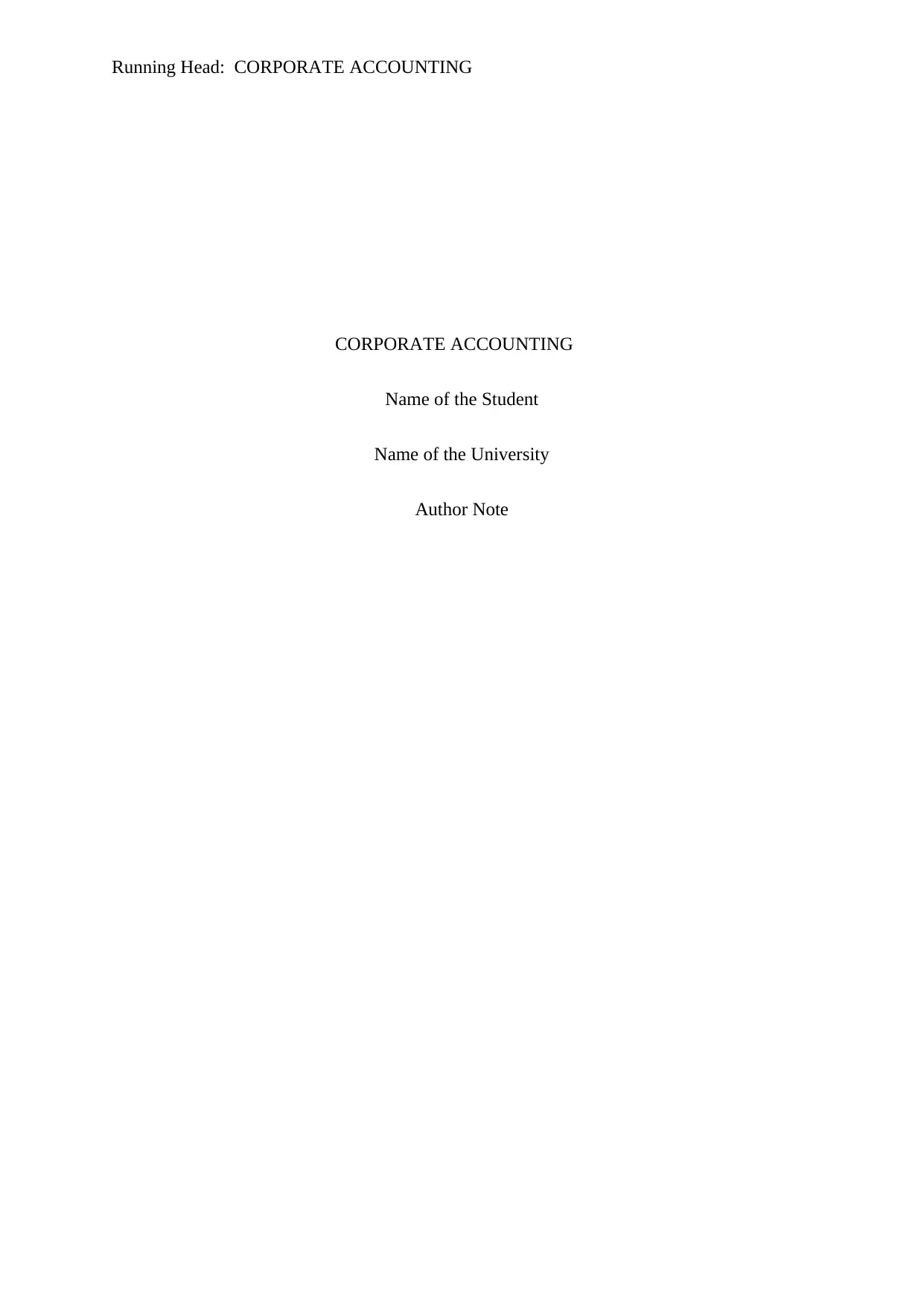
Running Head: CORPORATE ACCOUNTING
CORPORATE ACCOUNTING
Name of the Student
Name of the University
Author Note
CORPORATE ACCOUNTING
Name of the Student
Name of the University
Author Note
Paraphrase This Document
Need a fresh take? Get an instant paraphrase of this document with our AI Paraphraser
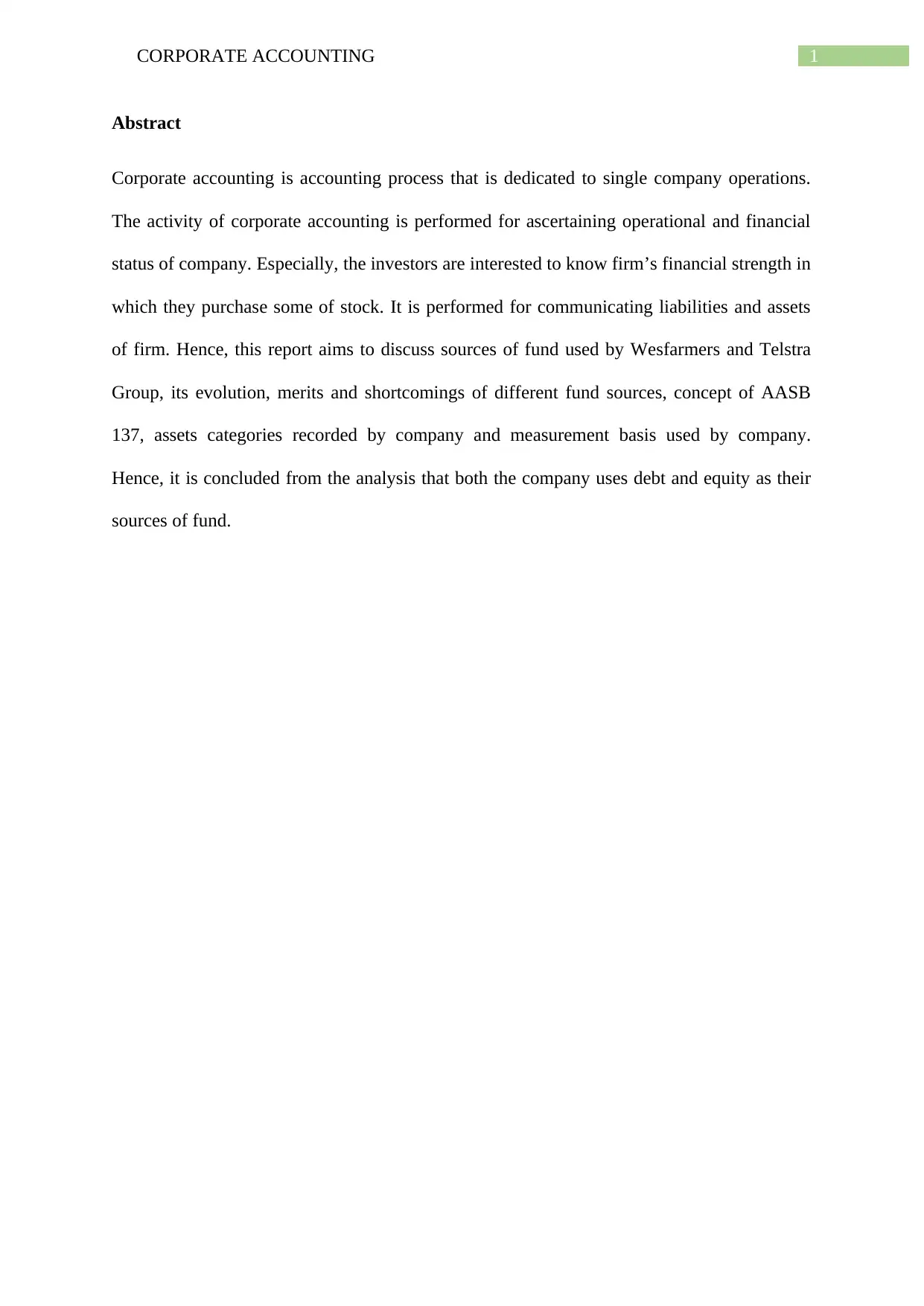
1CORPORATE ACCOUNTING
Abstract
Corporate accounting is accounting process that is dedicated to single company operations.
The activity of corporate accounting is performed for ascertaining operational and financial
status of company. Especially, the investors are interested to know firm’s financial strength in
which they purchase some of stock. It is performed for communicating liabilities and assets
of firm. Hence, this report aims to discuss sources of fund used by Wesfarmers and Telstra
Group, its evolution, merits and shortcomings of different fund sources, concept of AASB
137, assets categories recorded by company and measurement basis used by company.
Hence, it is concluded from the analysis that both the company uses debt and equity as their
sources of fund.
Abstract
Corporate accounting is accounting process that is dedicated to single company operations.
The activity of corporate accounting is performed for ascertaining operational and financial
status of company. Especially, the investors are interested to know firm’s financial strength in
which they purchase some of stock. It is performed for communicating liabilities and assets
of firm. Hence, this report aims to discuss sources of fund used by Wesfarmers and Telstra
Group, its evolution, merits and shortcomings of different fund sources, concept of AASB
137, assets categories recorded by company and measurement basis used by company.
Hence, it is concluded from the analysis that both the company uses debt and equity as their
sources of fund.
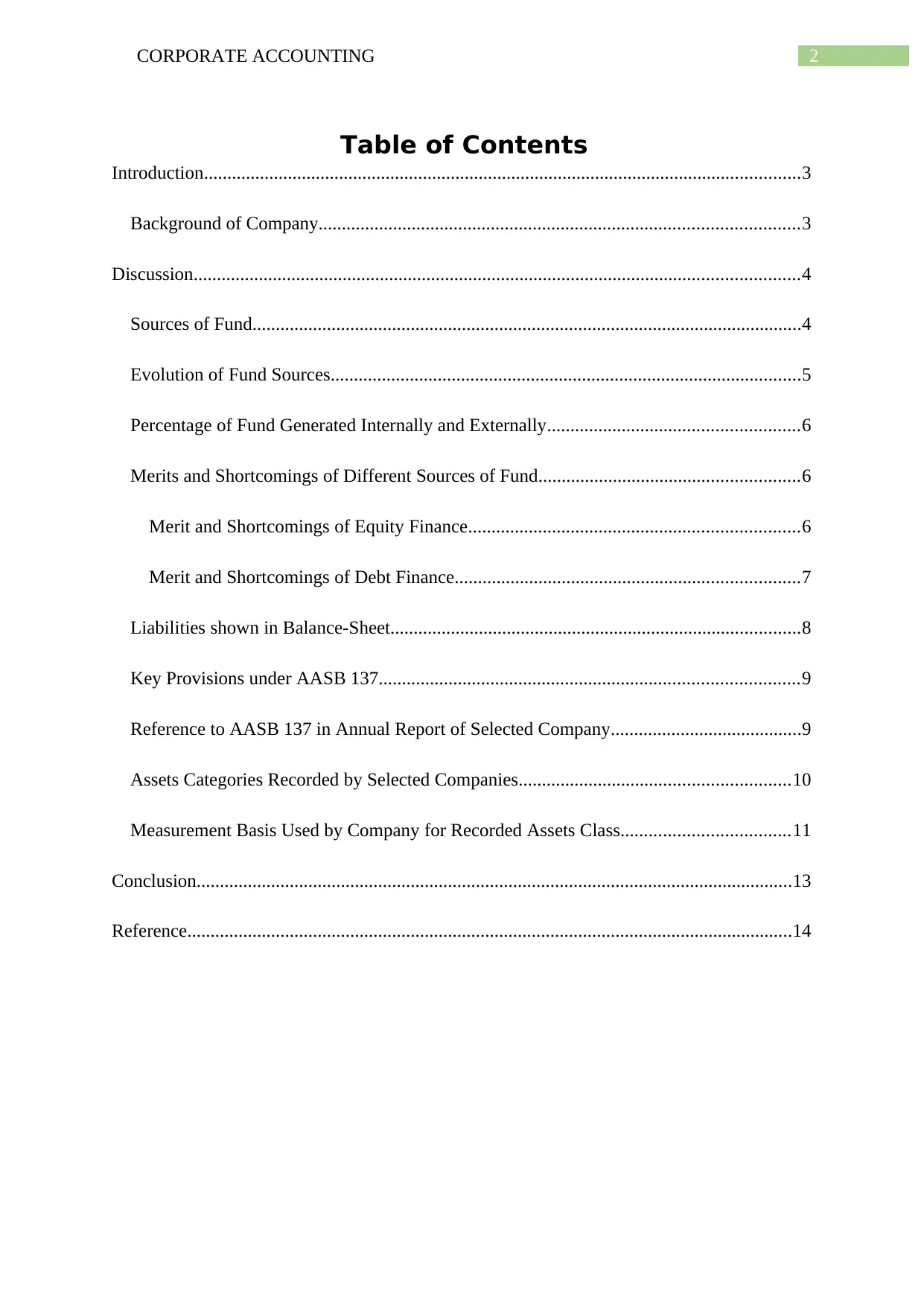
2CORPORATE ACCOUNTING
Table of Contents
Introduction................................................................................................................................3
Background of Company.......................................................................................................3
Discussion..................................................................................................................................4
Sources of Fund......................................................................................................................4
Evolution of Fund Sources.....................................................................................................5
Percentage of Fund Generated Internally and Externally......................................................6
Merits and Shortcomings of Different Sources of Fund........................................................6
Merit and Shortcomings of Equity Finance.......................................................................6
Merit and Shortcomings of Debt Finance..........................................................................7
Liabilities shown in Balance-Sheet........................................................................................8
Key Provisions under AASB 137..........................................................................................9
Reference to AASB 137 in Annual Report of Selected Company.........................................9
Assets Categories Recorded by Selected Companies..........................................................10
Measurement Basis Used by Company for Recorded Assets Class....................................11
Conclusion................................................................................................................................13
Reference..................................................................................................................................14
Table of Contents
Introduction................................................................................................................................3
Background of Company.......................................................................................................3
Discussion..................................................................................................................................4
Sources of Fund......................................................................................................................4
Evolution of Fund Sources.....................................................................................................5
Percentage of Fund Generated Internally and Externally......................................................6
Merits and Shortcomings of Different Sources of Fund........................................................6
Merit and Shortcomings of Equity Finance.......................................................................6
Merit and Shortcomings of Debt Finance..........................................................................7
Liabilities shown in Balance-Sheet........................................................................................8
Key Provisions under AASB 137..........................................................................................9
Reference to AASB 137 in Annual Report of Selected Company.........................................9
Assets Categories Recorded by Selected Companies..........................................................10
Measurement Basis Used by Company for Recorded Assets Class....................................11
Conclusion................................................................................................................................13
Reference..................................................................................................................................14
⊘ This is a preview!⊘
Do you want full access?
Subscribe today to unlock all pages.

Trusted by 1+ million students worldwide
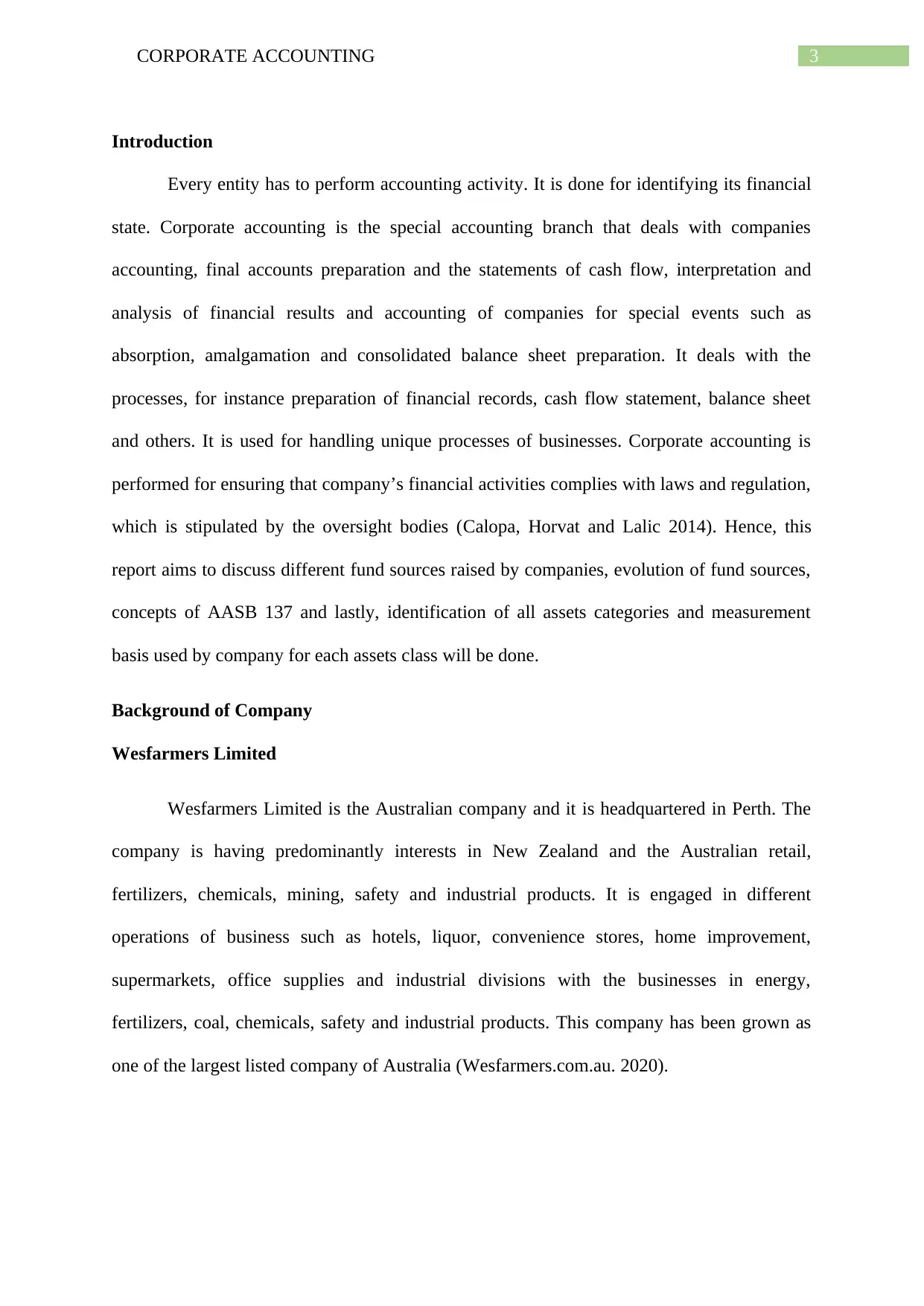
3CORPORATE ACCOUNTING
Introduction
Every entity has to perform accounting activity. It is done for identifying its financial
state. Corporate accounting is the special accounting branch that deals with companies
accounting, final accounts preparation and the statements of cash flow, interpretation and
analysis of financial results and accounting of companies for special events such as
absorption, amalgamation and consolidated balance sheet preparation. It deals with the
processes, for instance preparation of financial records, cash flow statement, balance sheet
and others. It is used for handling unique processes of businesses. Corporate accounting is
performed for ensuring that company’s financial activities complies with laws and regulation,
which is stipulated by the oversight bodies (Calopa, Horvat and Lalic 2014). Hence, this
report aims to discuss different fund sources raised by companies, evolution of fund sources,
concepts of AASB 137 and lastly, identification of all assets categories and measurement
basis used by company for each assets class will be done.
Background of Company
Wesfarmers Limited
Wesfarmers Limited is the Australian company and it is headquartered in Perth. The
company is having predominantly interests in New Zealand and the Australian retail,
fertilizers, chemicals, mining, safety and industrial products. It is engaged in different
operations of business such as hotels, liquor, convenience stores, home improvement,
supermarkets, office supplies and industrial divisions with the businesses in energy,
fertilizers, coal, chemicals, safety and industrial products. This company has been grown as
one of the largest listed company of Australia (Wesfarmers.com.au. 2020).
Introduction
Every entity has to perform accounting activity. It is done for identifying its financial
state. Corporate accounting is the special accounting branch that deals with companies
accounting, final accounts preparation and the statements of cash flow, interpretation and
analysis of financial results and accounting of companies for special events such as
absorption, amalgamation and consolidated balance sheet preparation. It deals with the
processes, for instance preparation of financial records, cash flow statement, balance sheet
and others. It is used for handling unique processes of businesses. Corporate accounting is
performed for ensuring that company’s financial activities complies with laws and regulation,
which is stipulated by the oversight bodies (Calopa, Horvat and Lalic 2014). Hence, this
report aims to discuss different fund sources raised by companies, evolution of fund sources,
concepts of AASB 137 and lastly, identification of all assets categories and measurement
basis used by company for each assets class will be done.
Background of Company
Wesfarmers Limited
Wesfarmers Limited is the Australian company and it is headquartered in Perth. The
company is having predominantly interests in New Zealand and the Australian retail,
fertilizers, chemicals, mining, safety and industrial products. It is engaged in different
operations of business such as hotels, liquor, convenience stores, home improvement,
supermarkets, office supplies and industrial divisions with the businesses in energy,
fertilizers, coal, chemicals, safety and industrial products. This company has been grown as
one of the largest listed company of Australia (Wesfarmers.com.au. 2020).
Paraphrase This Document
Need a fresh take? Get an instant paraphrase of this document with our AI Paraphraser
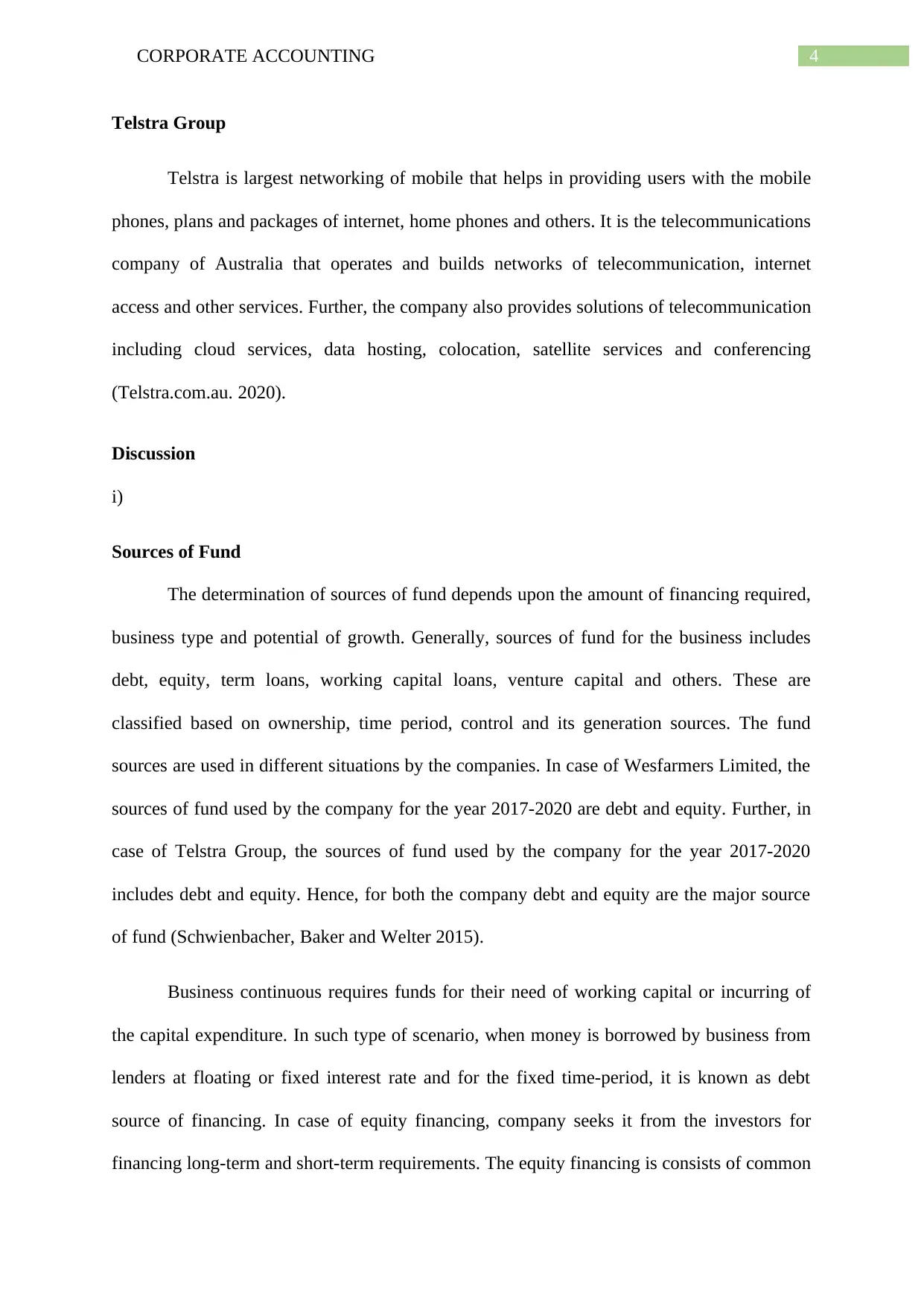
4CORPORATE ACCOUNTING
Telstra Group
Telstra is largest networking of mobile that helps in providing users with the mobile
phones, plans and packages of internet, home phones and others. It is the telecommunications
company of Australia that operates and builds networks of telecommunication, internet
access and other services. Further, the company also provides solutions of telecommunication
including cloud services, data hosting, colocation, satellite services and conferencing
(Telstra.com.au. 2020).
Discussion
i)
Sources of Fund
The determination of sources of fund depends upon the amount of financing required,
business type and potential of growth. Generally, sources of fund for the business includes
debt, equity, term loans, working capital loans, venture capital and others. These are
classified based on ownership, time period, control and its generation sources. The fund
sources are used in different situations by the companies. In case of Wesfarmers Limited, the
sources of fund used by the company for the year 2017-2020 are debt and equity. Further, in
case of Telstra Group, the sources of fund used by the company for the year 2017-2020
includes debt and equity. Hence, for both the company debt and equity are the major source
of fund (Schwienbacher, Baker and Welter 2015).
Business continuous requires funds for their need of working capital or incurring of
the capital expenditure. In such type of scenario, when money is borrowed by business from
lenders at floating or fixed interest rate and for the fixed time-period, it is known as debt
source of financing. In case of equity financing, company seeks it from the investors for
financing long-term and short-term requirements. The equity financing is consists of common
Telstra Group
Telstra is largest networking of mobile that helps in providing users with the mobile
phones, plans and packages of internet, home phones and others. It is the telecommunications
company of Australia that operates and builds networks of telecommunication, internet
access and other services. Further, the company also provides solutions of telecommunication
including cloud services, data hosting, colocation, satellite services and conferencing
(Telstra.com.au. 2020).
Discussion
i)
Sources of Fund
The determination of sources of fund depends upon the amount of financing required,
business type and potential of growth. Generally, sources of fund for the business includes
debt, equity, term loans, working capital loans, venture capital and others. These are
classified based on ownership, time period, control and its generation sources. The fund
sources are used in different situations by the companies. In case of Wesfarmers Limited, the
sources of fund used by the company for the year 2017-2020 are debt and equity. Further, in
case of Telstra Group, the sources of fund used by the company for the year 2017-2020
includes debt and equity. Hence, for both the company debt and equity are the major source
of fund (Schwienbacher, Baker and Welter 2015).
Business continuous requires funds for their need of working capital or incurring of
the capital expenditure. In such type of scenario, when money is borrowed by business from
lenders at floating or fixed interest rate and for the fixed time-period, it is known as debt
source of financing. In case of equity financing, company seeks it from the investors for
financing long-term and short-term requirements. The equity financing is consists of common
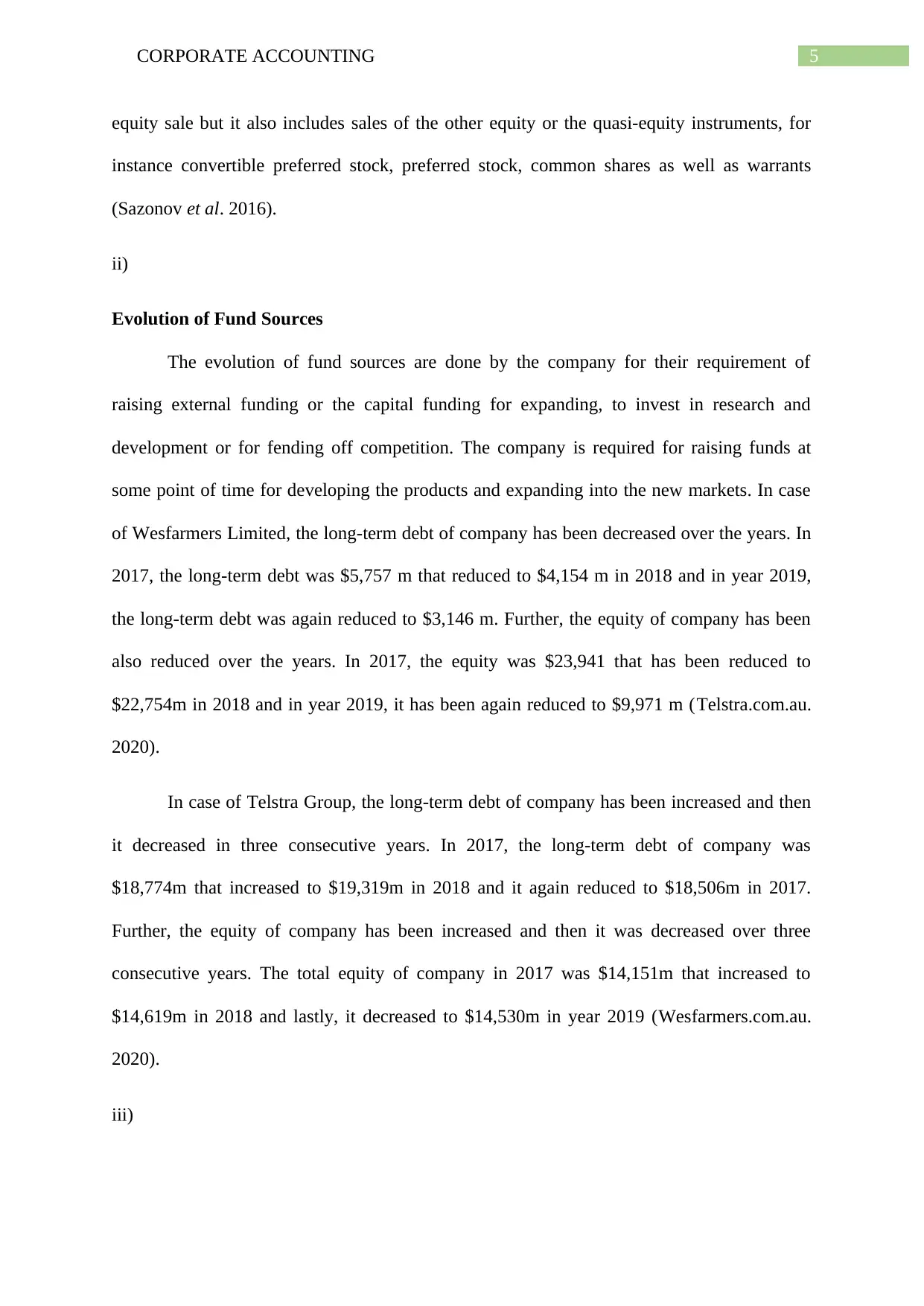
5CORPORATE ACCOUNTING
equity sale but it also includes sales of the other equity or the quasi-equity instruments, for
instance convertible preferred stock, preferred stock, common shares as well as warrants
(Sazonov et al. 2016).
ii)
Evolution of Fund Sources
The evolution of fund sources are done by the company for their requirement of
raising external funding or the capital funding for expanding, to invest in research and
development or for fending off competition. The company is required for raising funds at
some point of time for developing the products and expanding into the new markets. In case
of Wesfarmers Limited, the long-term debt of company has been decreased over the years. In
2017, the long-term debt was $5,757 m that reduced to $4,154 m in 2018 and in year 2019,
the long-term debt was again reduced to $3,146 m. Further, the equity of company has been
also reduced over the years. In 2017, the equity was $23,941 that has been reduced to
$22,754m in 2018 and in year 2019, it has been again reduced to $9,971 m (Telstra.com.au.
2020).
In case of Telstra Group, the long-term debt of company has been increased and then
it decreased in three consecutive years. In 2017, the long-term debt of company was
$18,774m that increased to $19,319m in 2018 and it again reduced to $18,506m in 2017.
Further, the equity of company has been increased and then it was decreased over three
consecutive years. The total equity of company in 2017 was $14,151m that increased to
$14,619m in 2018 and lastly, it decreased to $14,530m in year 2019 (Wesfarmers.com.au.
2020).
iii)
equity sale but it also includes sales of the other equity or the quasi-equity instruments, for
instance convertible preferred stock, preferred stock, common shares as well as warrants
(Sazonov et al. 2016).
ii)
Evolution of Fund Sources
The evolution of fund sources are done by the company for their requirement of
raising external funding or the capital funding for expanding, to invest in research and
development or for fending off competition. The company is required for raising funds at
some point of time for developing the products and expanding into the new markets. In case
of Wesfarmers Limited, the long-term debt of company has been decreased over the years. In
2017, the long-term debt was $5,757 m that reduced to $4,154 m in 2018 and in year 2019,
the long-term debt was again reduced to $3,146 m. Further, the equity of company has been
also reduced over the years. In 2017, the equity was $23,941 that has been reduced to
$22,754m in 2018 and in year 2019, it has been again reduced to $9,971 m (Telstra.com.au.
2020).
In case of Telstra Group, the long-term debt of company has been increased and then
it decreased in three consecutive years. In 2017, the long-term debt of company was
$18,774m that increased to $19,319m in 2018 and it again reduced to $18,506m in 2017.
Further, the equity of company has been increased and then it was decreased over three
consecutive years. The total equity of company in 2017 was $14,151m that increased to
$14,619m in 2018 and lastly, it decreased to $14,530m in year 2019 (Wesfarmers.com.au.
2020).
iii)
⊘ This is a preview!⊘
Do you want full access?
Subscribe today to unlock all pages.

Trusted by 1+ million students worldwide
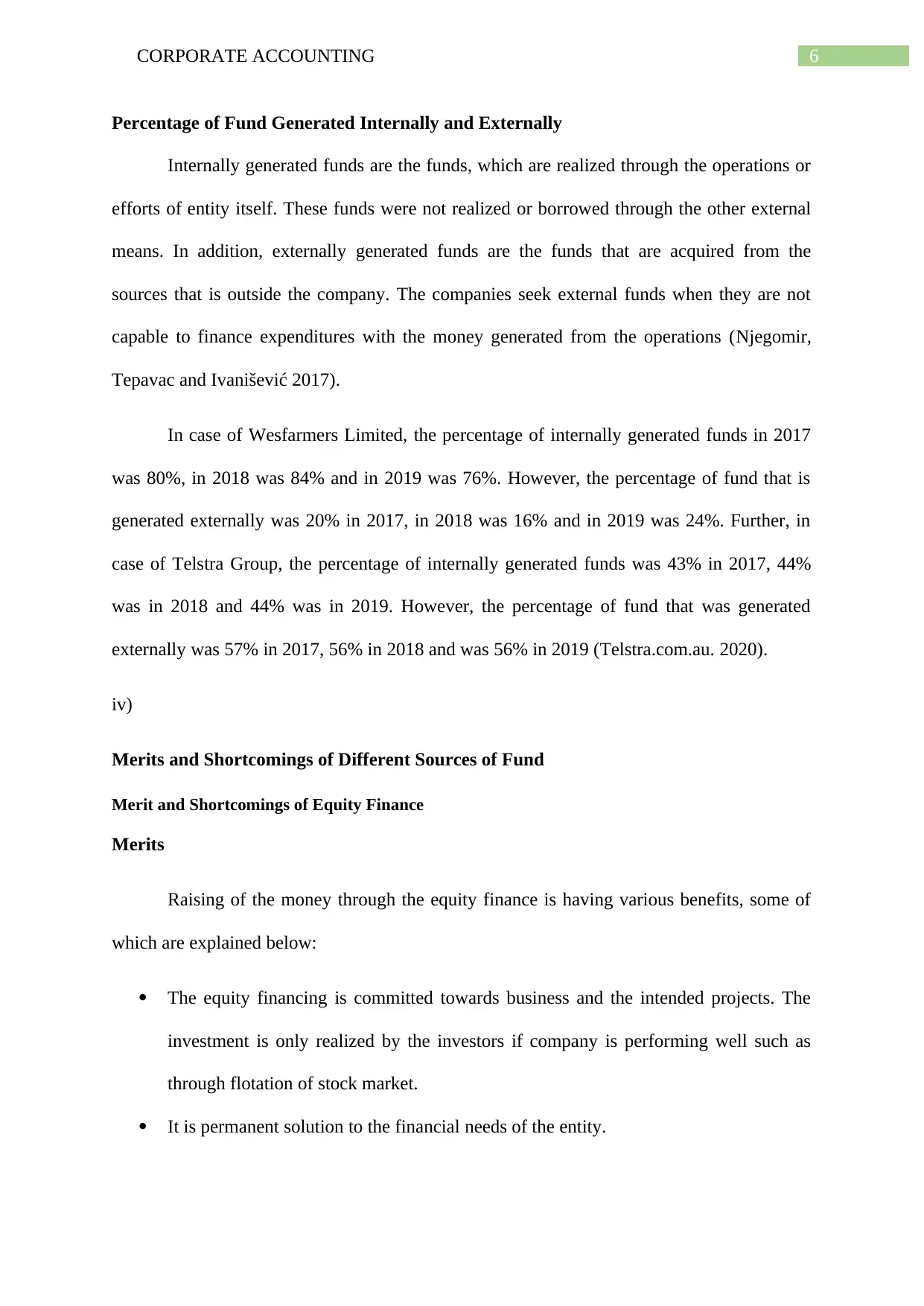
6CORPORATE ACCOUNTING
Percentage of Fund Generated Internally and Externally
Internally generated funds are the funds, which are realized through the operations or
efforts of entity itself. These funds were not realized or borrowed through the other external
means. In addition, externally generated funds are the funds that are acquired from the
sources that is outside the company. The companies seek external funds when they are not
capable to finance expenditures with the money generated from the operations (Njegomir,
Tepavac and Ivanišević 2017).
In case of Wesfarmers Limited, the percentage of internally generated funds in 2017
was 80%, in 2018 was 84% and in 2019 was 76%. However, the percentage of fund that is
generated externally was 20% in 2017, in 2018 was 16% and in 2019 was 24%. Further, in
case of Telstra Group, the percentage of internally generated funds was 43% in 2017, 44%
was in 2018 and 44% was in 2019. However, the percentage of fund that was generated
externally was 57% in 2017, 56% in 2018 and was 56% in 2019 (Telstra.com.au. 2020).
iv)
Merits and Shortcomings of Different Sources of Fund
Merit and Shortcomings of Equity Finance
Merits
Raising of the money through the equity finance is having various benefits, some of
which are explained below:
The equity financing is committed towards business and the intended projects. The
investment is only realized by the investors if company is performing well such as
through flotation of stock market.
It is permanent solution to the financial needs of the entity.
Percentage of Fund Generated Internally and Externally
Internally generated funds are the funds, which are realized through the operations or
efforts of entity itself. These funds were not realized or borrowed through the other external
means. In addition, externally generated funds are the funds that are acquired from the
sources that is outside the company. The companies seek external funds when they are not
capable to finance expenditures with the money generated from the operations (Njegomir,
Tepavac and Ivanišević 2017).
In case of Wesfarmers Limited, the percentage of internally generated funds in 2017
was 80%, in 2018 was 84% and in 2019 was 76%. However, the percentage of fund that is
generated externally was 20% in 2017, in 2018 was 16% and in 2019 was 24%. Further, in
case of Telstra Group, the percentage of internally generated funds was 43% in 2017, 44%
was in 2018 and 44% was in 2019. However, the percentage of fund that was generated
externally was 57% in 2017, 56% in 2018 and was 56% in 2019 (Telstra.com.au. 2020).
iv)
Merits and Shortcomings of Different Sources of Fund
Merit and Shortcomings of Equity Finance
Merits
Raising of the money through the equity finance is having various benefits, some of
which are explained below:
The equity financing is committed towards business and the intended projects. The
investment is only realized by the investors if company is performing well such as
through flotation of stock market.
It is permanent solution to the financial needs of the entity.
Paraphrase This Document
Need a fresh take? Get an instant paraphrase of this document with our AI Paraphraser
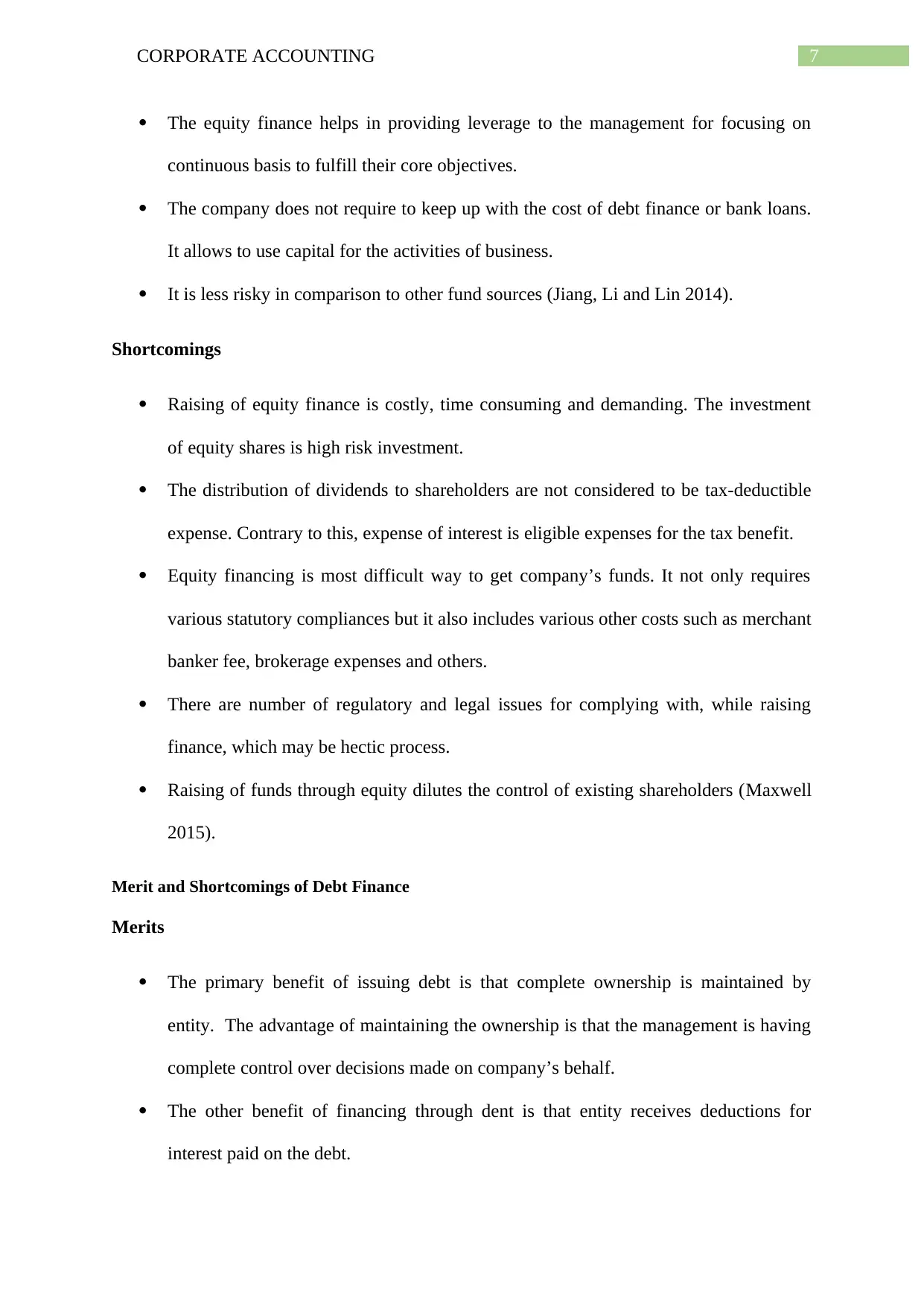
7CORPORATE ACCOUNTING
The equity finance helps in providing leverage to the management for focusing on
continuous basis to fulfill their core objectives.
The company does not require to keep up with the cost of debt finance or bank loans.
It allows to use capital for the activities of business.
It is less risky in comparison to other fund sources (Jiang, Li and Lin 2014).
Shortcomings
Raising of equity finance is costly, time consuming and demanding. The investment
of equity shares is high risk investment.
The distribution of dividends to shareholders are not considered to be tax-deductible
expense. Contrary to this, expense of interest is eligible expenses for the tax benefit.
Equity financing is most difficult way to get company’s funds. It not only requires
various statutory compliances but it also includes various other costs such as merchant
banker fee, brokerage expenses and others.
There are number of regulatory and legal issues for complying with, while raising
finance, which may be hectic process.
Raising of funds through equity dilutes the control of existing shareholders (Maxwell
2015).
Merit and Shortcomings of Debt Finance
Merits
The primary benefit of issuing debt is that complete ownership is maintained by
entity. The advantage of maintaining the ownership is that the management is having
complete control over decisions made on company’s behalf.
The other benefit of financing through dent is that entity receives deductions for
interest paid on the debt.
The equity finance helps in providing leverage to the management for focusing on
continuous basis to fulfill their core objectives.
The company does not require to keep up with the cost of debt finance or bank loans.
It allows to use capital for the activities of business.
It is less risky in comparison to other fund sources (Jiang, Li and Lin 2014).
Shortcomings
Raising of equity finance is costly, time consuming and demanding. The investment
of equity shares is high risk investment.
The distribution of dividends to shareholders are not considered to be tax-deductible
expense. Contrary to this, expense of interest is eligible expenses for the tax benefit.
Equity financing is most difficult way to get company’s funds. It not only requires
various statutory compliances but it also includes various other costs such as merchant
banker fee, brokerage expenses and others.
There are number of regulatory and legal issues for complying with, while raising
finance, which may be hectic process.
Raising of funds through equity dilutes the control of existing shareholders (Maxwell
2015).
Merit and Shortcomings of Debt Finance
Merits
The primary benefit of issuing debt is that complete ownership is maintained by
entity. The advantage of maintaining the ownership is that the management is having
complete control over decisions made on company’s behalf.
The other benefit of financing through dent is that entity receives deductions for
interest paid on the debt.
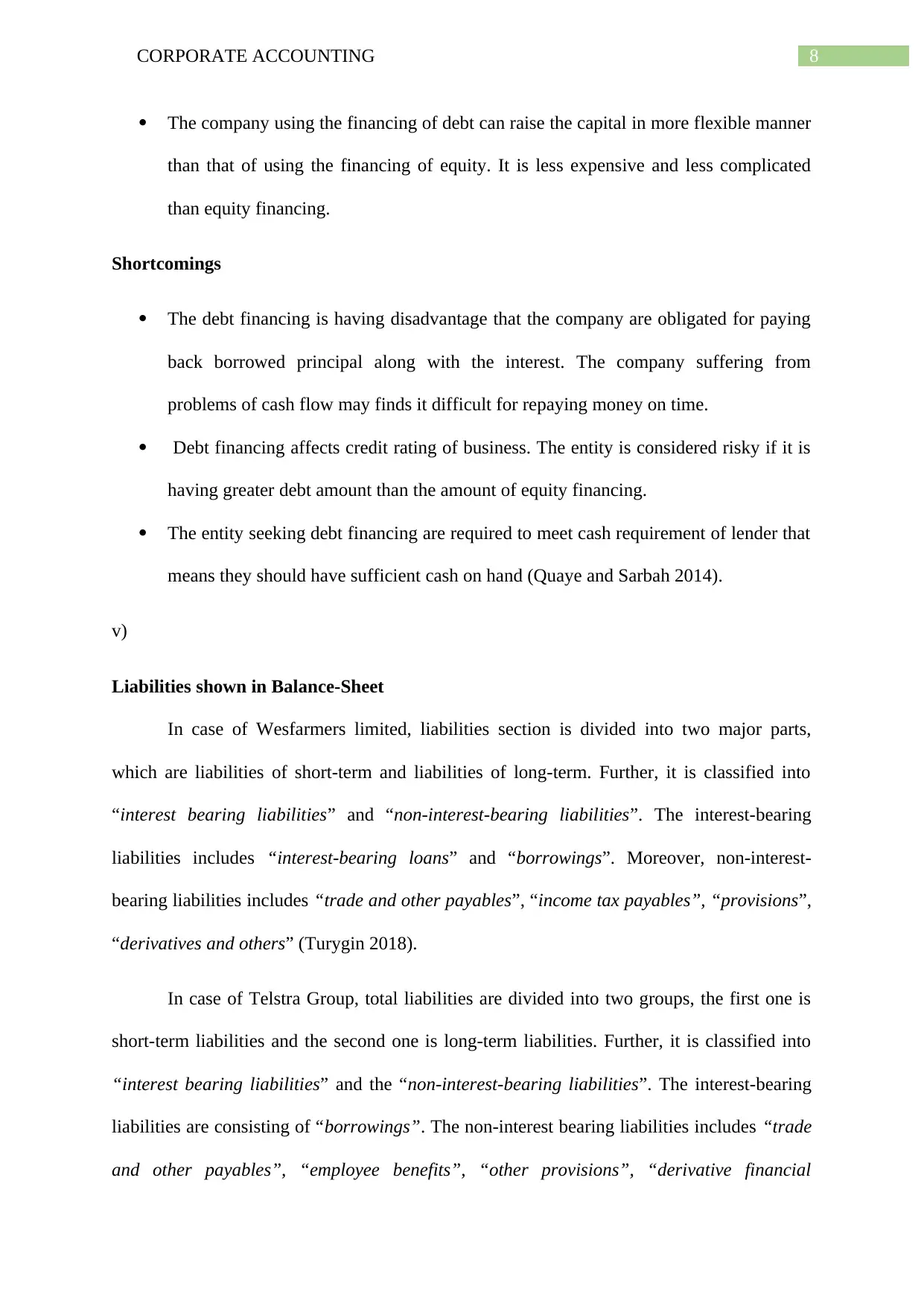
8CORPORATE ACCOUNTING
The company using the financing of debt can raise the capital in more flexible manner
than that of using the financing of equity. It is less expensive and less complicated
than equity financing.
Shortcomings
The debt financing is having disadvantage that the company are obligated for paying
back borrowed principal along with the interest. The company suffering from
problems of cash flow may finds it difficult for repaying money on time.
Debt financing affects credit rating of business. The entity is considered risky if it is
having greater debt amount than the amount of equity financing.
The entity seeking debt financing are required to meet cash requirement of lender that
means they should have sufficient cash on hand (Quaye and Sarbah 2014).
v)
Liabilities shown in Balance-Sheet
In case of Wesfarmers limited, liabilities section is divided into two major parts,
which are liabilities of short-term and liabilities of long-term. Further, it is classified into
“interest bearing liabilities” and “non-interest-bearing liabilities”. The interest-bearing
liabilities includes “interest-bearing loans” and “borrowings”. Moreover, non-interest-
bearing liabilities includes “trade and other payables”, “income tax payables”, “provisions”,
“derivatives and others” (Turygin 2018).
In case of Telstra Group, total liabilities are divided into two groups, the first one is
short-term liabilities and the second one is long-term liabilities. Further, it is classified into
“interest bearing liabilities” and the “non-interest-bearing liabilities”. The interest-bearing
liabilities are consisting of “borrowings”. The non-interest bearing liabilities includes “trade
and other payables”, “employee benefits”, “other provisions”, “derivative financial
The company using the financing of debt can raise the capital in more flexible manner
than that of using the financing of equity. It is less expensive and less complicated
than equity financing.
Shortcomings
The debt financing is having disadvantage that the company are obligated for paying
back borrowed principal along with the interest. The company suffering from
problems of cash flow may finds it difficult for repaying money on time.
Debt financing affects credit rating of business. The entity is considered risky if it is
having greater debt amount than the amount of equity financing.
The entity seeking debt financing are required to meet cash requirement of lender that
means they should have sufficient cash on hand (Quaye and Sarbah 2014).
v)
Liabilities shown in Balance-Sheet
In case of Wesfarmers limited, liabilities section is divided into two major parts,
which are liabilities of short-term and liabilities of long-term. Further, it is classified into
“interest bearing liabilities” and “non-interest-bearing liabilities”. The interest-bearing
liabilities includes “interest-bearing loans” and “borrowings”. Moreover, non-interest-
bearing liabilities includes “trade and other payables”, “income tax payables”, “provisions”,
“derivatives and others” (Turygin 2018).
In case of Telstra Group, total liabilities are divided into two groups, the first one is
short-term liabilities and the second one is long-term liabilities. Further, it is classified into
“interest bearing liabilities” and the “non-interest-bearing liabilities”. The interest-bearing
liabilities are consisting of “borrowings”. The non-interest bearing liabilities includes “trade
and other payables”, “employee benefits”, “other provisions”, “derivative financial
⊘ This is a preview!⊘
Do you want full access?
Subscribe today to unlock all pages.

Trusted by 1+ million students worldwide
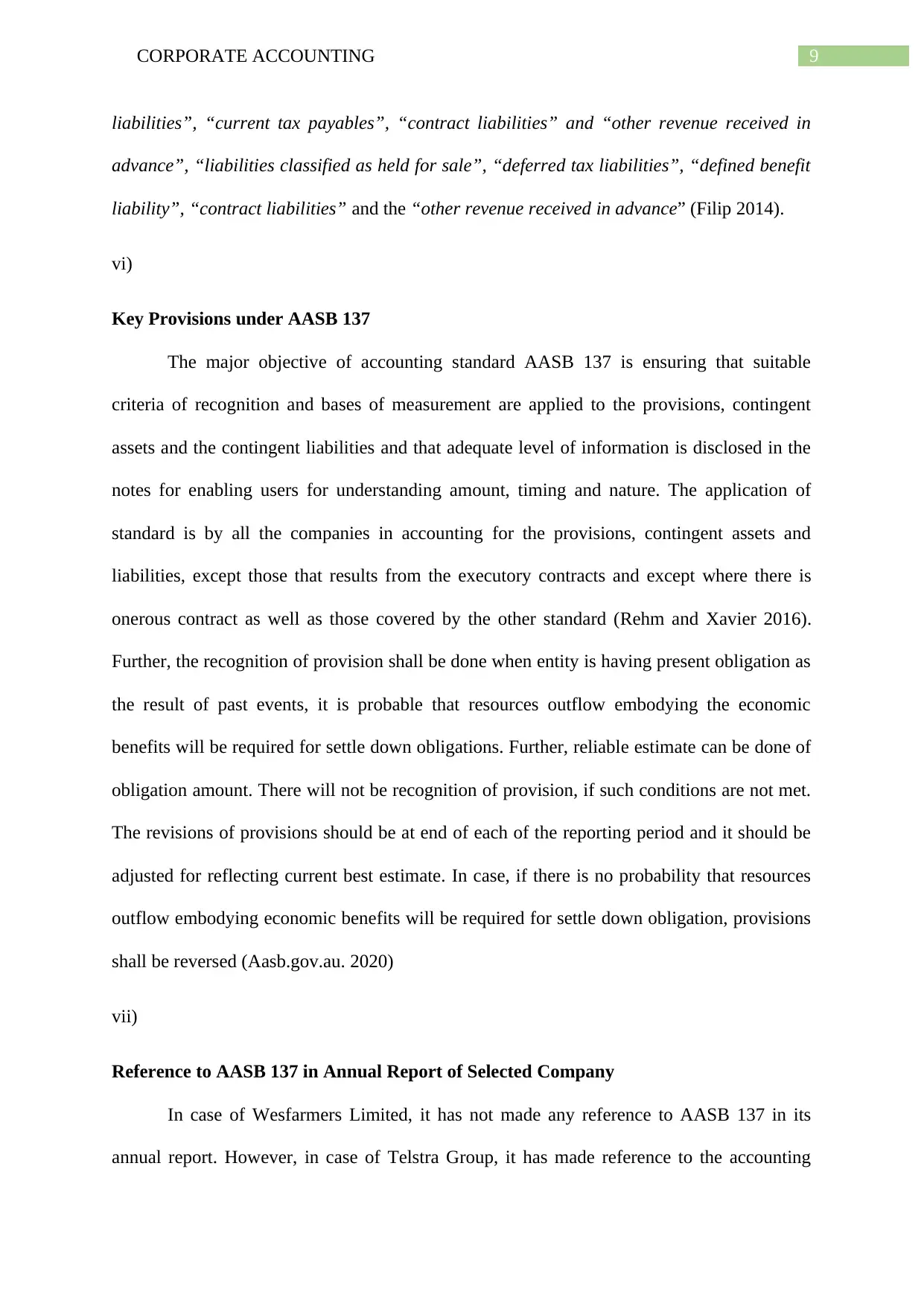
9CORPORATE ACCOUNTING
liabilities”, “current tax payables”, “contract liabilities” and “other revenue received in
advance”, “liabilities classified as held for sale”, “deferred tax liabilities”, “defined benefit
liability”, “contract liabilities” and the “other revenue received in advance” (Filip 2014).
vi)
Key Provisions under AASB 137
The major objective of accounting standard AASB 137 is ensuring that suitable
criteria of recognition and bases of measurement are applied to the provisions, contingent
assets and the contingent liabilities and that adequate level of information is disclosed in the
notes for enabling users for understanding amount, timing and nature. The application of
standard is by all the companies in accounting for the provisions, contingent assets and
liabilities, except those that results from the executory contracts and except where there is
onerous contract as well as those covered by the other standard (Rehm and Xavier 2016).
Further, the recognition of provision shall be done when entity is having present obligation as
the result of past events, it is probable that resources outflow embodying the economic
benefits will be required for settle down obligations. Further, reliable estimate can be done of
obligation amount. There will not be recognition of provision, if such conditions are not met.
The revisions of provisions should be at end of each of the reporting period and it should be
adjusted for reflecting current best estimate. In case, if there is no probability that resources
outflow embodying economic benefits will be required for settle down obligation, provisions
shall be reversed (Aasb.gov.au. 2020)
vii)
Reference to AASB 137 in Annual Report of Selected Company
In case of Wesfarmers Limited, it has not made any reference to AASB 137 in its
annual report. However, in case of Telstra Group, it has made reference to the accounting
liabilities”, “current tax payables”, “contract liabilities” and “other revenue received in
advance”, “liabilities classified as held for sale”, “deferred tax liabilities”, “defined benefit
liability”, “contract liabilities” and the “other revenue received in advance” (Filip 2014).
vi)
Key Provisions under AASB 137
The major objective of accounting standard AASB 137 is ensuring that suitable
criteria of recognition and bases of measurement are applied to the provisions, contingent
assets and the contingent liabilities and that adequate level of information is disclosed in the
notes for enabling users for understanding amount, timing and nature. The application of
standard is by all the companies in accounting for the provisions, contingent assets and
liabilities, except those that results from the executory contracts and except where there is
onerous contract as well as those covered by the other standard (Rehm and Xavier 2016).
Further, the recognition of provision shall be done when entity is having present obligation as
the result of past events, it is probable that resources outflow embodying the economic
benefits will be required for settle down obligations. Further, reliable estimate can be done of
obligation amount. There will not be recognition of provision, if such conditions are not met.
The revisions of provisions should be at end of each of the reporting period and it should be
adjusted for reflecting current best estimate. In case, if there is no probability that resources
outflow embodying economic benefits will be required for settle down obligation, provisions
shall be reversed (Aasb.gov.au. 2020)
vii)
Reference to AASB 137 in Annual Report of Selected Company
In case of Wesfarmers Limited, it has not made any reference to AASB 137 in its
annual report. However, in case of Telstra Group, it has made reference to the accounting
Paraphrase This Document
Need a fresh take? Get an instant paraphrase of this document with our AI Paraphraser
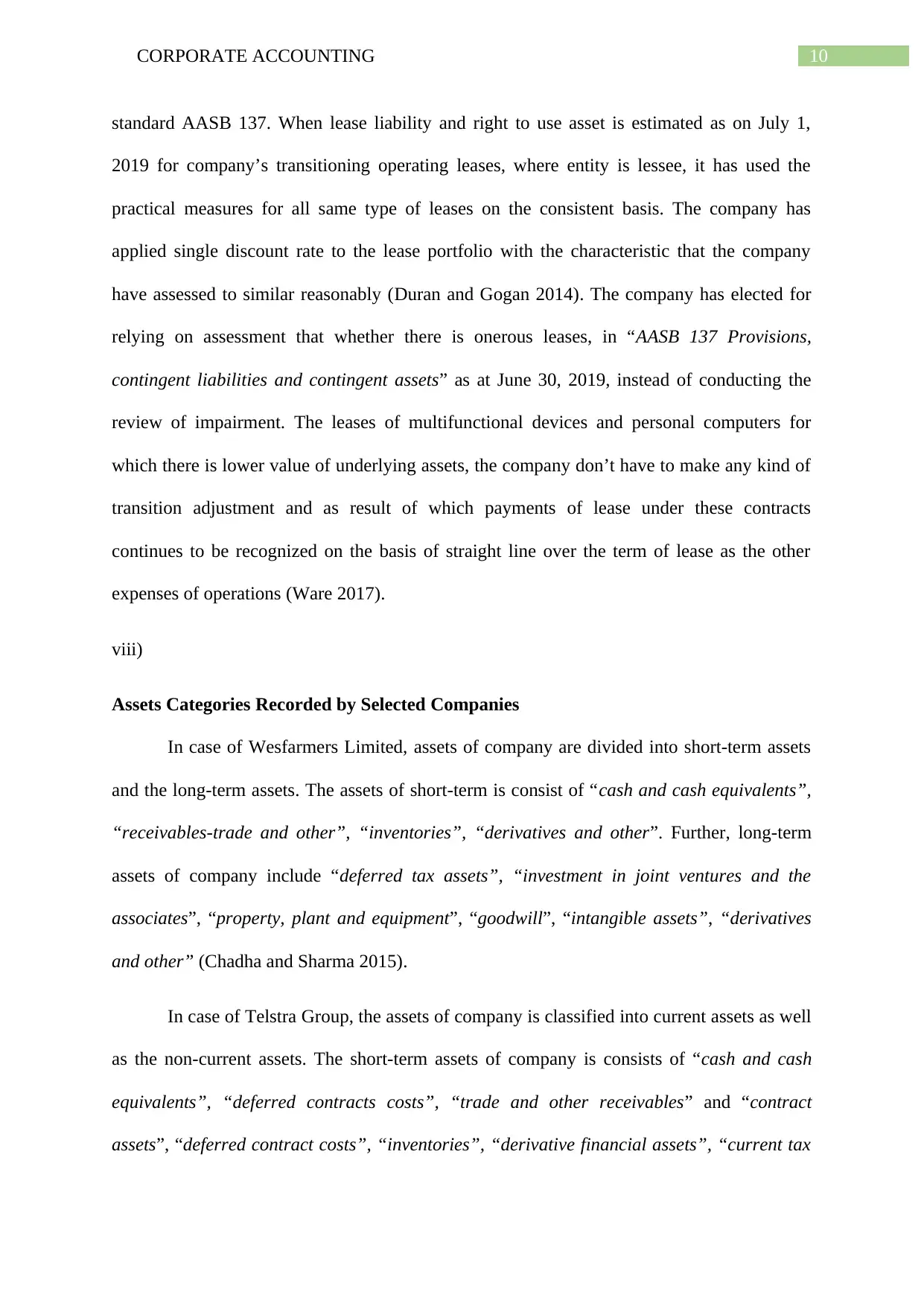
10CORPORATE ACCOUNTING
standard AASB 137. When lease liability and right to use asset is estimated as on July 1,
2019 for company’s transitioning operating leases, where entity is lessee, it has used the
practical measures for all same type of leases on the consistent basis. The company has
applied single discount rate to the lease portfolio with the characteristic that the company
have assessed to similar reasonably (Duran and Gogan 2014). The company has elected for
relying on assessment that whether there is onerous leases, in “AASB 137 Provisions,
contingent liabilities and contingent assets” as at June 30, 2019, instead of conducting the
review of impairment. The leases of multifunctional devices and personal computers for
which there is lower value of underlying assets, the company don’t have to make any kind of
transition adjustment and as result of which payments of lease under these contracts
continues to be recognized on the basis of straight line over the term of lease as the other
expenses of operations (Ware 2017).
viii)
Assets Categories Recorded by Selected Companies
In case of Wesfarmers Limited, assets of company are divided into short-term assets
and the long-term assets. The assets of short-term is consist of “cash and cash equivalents”,
“receivables-trade and other”, “inventories”, “derivatives and other”. Further, long-term
assets of company include “deferred tax assets”, “investment in joint ventures and the
associates”, “property, plant and equipment”, “goodwill”, “intangible assets”, “derivatives
and other” (Chadha and Sharma 2015).
In case of Telstra Group, the assets of company is classified into current assets as well
as the non-current assets. The short-term assets of company is consists of “cash and cash
equivalents”, “deferred contracts costs”, “trade and other receivables” and “contract
assets”, “deferred contract costs”, “inventories”, “derivative financial assets”, “current tax
standard AASB 137. When lease liability and right to use asset is estimated as on July 1,
2019 for company’s transitioning operating leases, where entity is lessee, it has used the
practical measures for all same type of leases on the consistent basis. The company has
applied single discount rate to the lease portfolio with the characteristic that the company
have assessed to similar reasonably (Duran and Gogan 2014). The company has elected for
relying on assessment that whether there is onerous leases, in “AASB 137 Provisions,
contingent liabilities and contingent assets” as at June 30, 2019, instead of conducting the
review of impairment. The leases of multifunctional devices and personal computers for
which there is lower value of underlying assets, the company don’t have to make any kind of
transition adjustment and as result of which payments of lease under these contracts
continues to be recognized on the basis of straight line over the term of lease as the other
expenses of operations (Ware 2017).
viii)
Assets Categories Recorded by Selected Companies
In case of Wesfarmers Limited, assets of company are divided into short-term assets
and the long-term assets. The assets of short-term is consist of “cash and cash equivalents”,
“receivables-trade and other”, “inventories”, “derivatives and other”. Further, long-term
assets of company include “deferred tax assets”, “investment in joint ventures and the
associates”, “property, plant and equipment”, “goodwill”, “intangible assets”, “derivatives
and other” (Chadha and Sharma 2015).
In case of Telstra Group, the assets of company is classified into current assets as well
as the non-current assets. The short-term assets of company is consists of “cash and cash
equivalents”, “deferred contracts costs”, “trade and other receivables” and “contract
assets”, “deferred contract costs”, “inventories”, “derivative financial assets”, “current tax
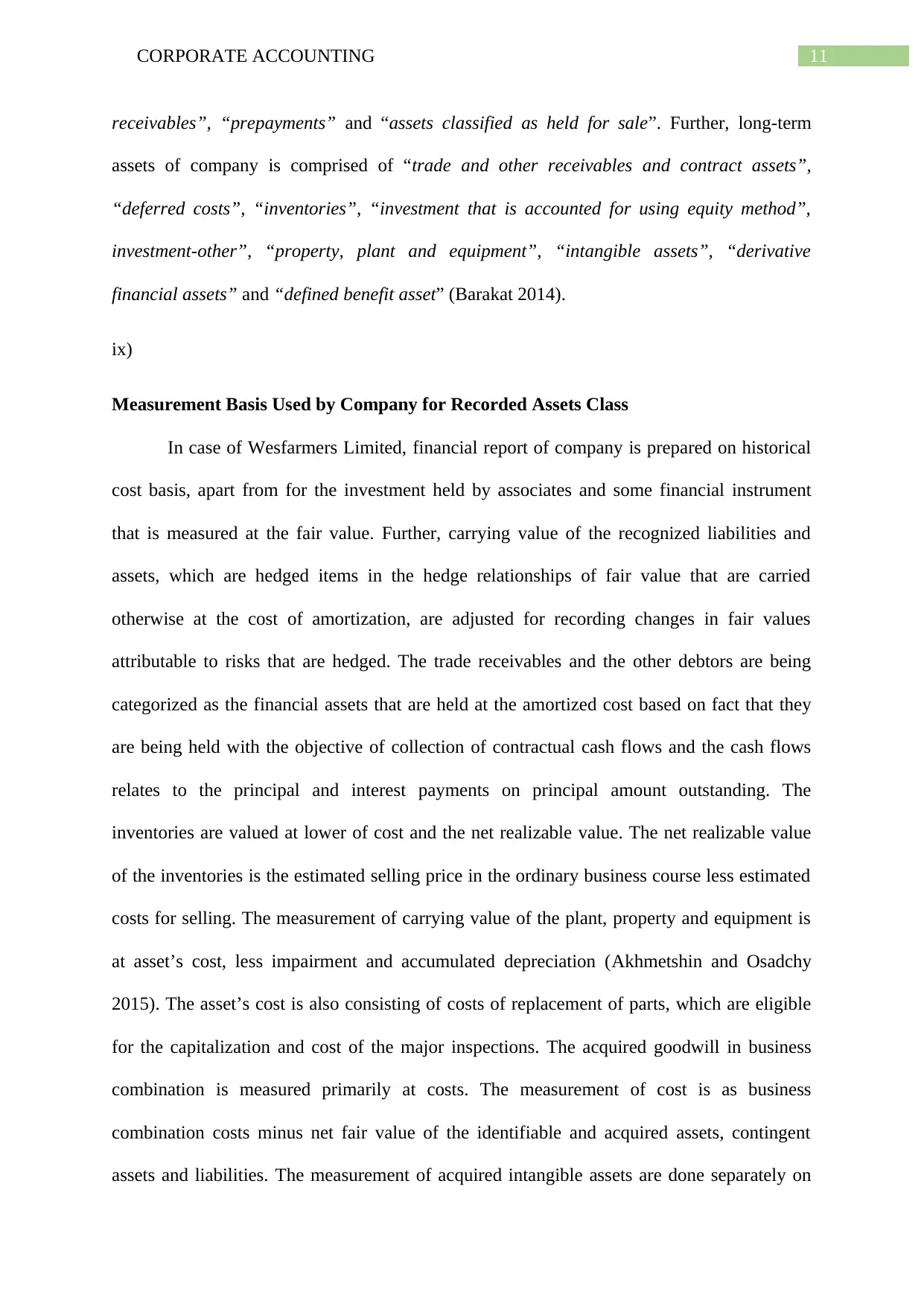
11CORPORATE ACCOUNTING
receivables”, “prepayments” and “assets classified as held for sale”. Further, long-term
assets of company is comprised of “trade and other receivables and contract assets”,
“deferred costs”, “inventories”, “investment that is accounted for using equity method”,
investment-other”, “property, plant and equipment”, “intangible assets”, “derivative
financial assets” and “defined benefit asset” (Barakat 2014).
ix)
Measurement Basis Used by Company for Recorded Assets Class
In case of Wesfarmers Limited, financial report of company is prepared on historical
cost basis, apart from for the investment held by associates and some financial instrument
that is measured at the fair value. Further, carrying value of the recognized liabilities and
assets, which are hedged items in the hedge relationships of fair value that are carried
otherwise at the cost of amortization, are adjusted for recording changes in fair values
attributable to risks that are hedged. The trade receivables and the other debtors are being
categorized as the financial assets that are held at the amortized cost based on fact that they
are being held with the objective of collection of contractual cash flows and the cash flows
relates to the principal and interest payments on principal amount outstanding. The
inventories are valued at lower of cost and the net realizable value. The net realizable value
of the inventories is the estimated selling price in the ordinary business course less estimated
costs for selling. The measurement of carrying value of the plant, property and equipment is
at asset’s cost, less impairment and accumulated depreciation (Akhmetshin and Osadchy
2015). The asset’s cost is also consisting of costs of replacement of parts, which are eligible
for the capitalization and cost of the major inspections. The acquired goodwill in business
combination is measured primarily at costs. The measurement of cost is as business
combination costs minus net fair value of the identifiable and acquired assets, contingent
assets and liabilities. The measurement of acquired intangible assets are done separately on
receivables”, “prepayments” and “assets classified as held for sale”. Further, long-term
assets of company is comprised of “trade and other receivables and contract assets”,
“deferred costs”, “inventories”, “investment that is accounted for using equity method”,
investment-other”, “property, plant and equipment”, “intangible assets”, “derivative
financial assets” and “defined benefit asset” (Barakat 2014).
ix)
Measurement Basis Used by Company for Recorded Assets Class
In case of Wesfarmers Limited, financial report of company is prepared on historical
cost basis, apart from for the investment held by associates and some financial instrument
that is measured at the fair value. Further, carrying value of the recognized liabilities and
assets, which are hedged items in the hedge relationships of fair value that are carried
otherwise at the cost of amortization, are adjusted for recording changes in fair values
attributable to risks that are hedged. The trade receivables and the other debtors are being
categorized as the financial assets that are held at the amortized cost based on fact that they
are being held with the objective of collection of contractual cash flows and the cash flows
relates to the principal and interest payments on principal amount outstanding. The
inventories are valued at lower of cost and the net realizable value. The net realizable value
of the inventories is the estimated selling price in the ordinary business course less estimated
costs for selling. The measurement of carrying value of the plant, property and equipment is
at asset’s cost, less impairment and accumulated depreciation (Akhmetshin and Osadchy
2015). The asset’s cost is also consisting of costs of replacement of parts, which are eligible
for the capitalization and cost of the major inspections. The acquired goodwill in business
combination is measured primarily at costs. The measurement of cost is as business
combination costs minus net fair value of the identifiable and acquired assets, contingent
assets and liabilities. The measurement of acquired intangible assets are done separately on
⊘ This is a preview!⊘
Do you want full access?
Subscribe today to unlock all pages.

Trusted by 1+ million students worldwide
1 out of 17
Related Documents
Your All-in-One AI-Powered Toolkit for Academic Success.
+13062052269
info@desklib.com
Available 24*7 on WhatsApp / Email
![[object Object]](/_next/static/media/star-bottom.7253800d.svg)
Unlock your academic potential
Copyright © 2020–2025 A2Z Services. All Rights Reserved. Developed and managed by ZUCOL.





